Ferry Bridge – The Bridge
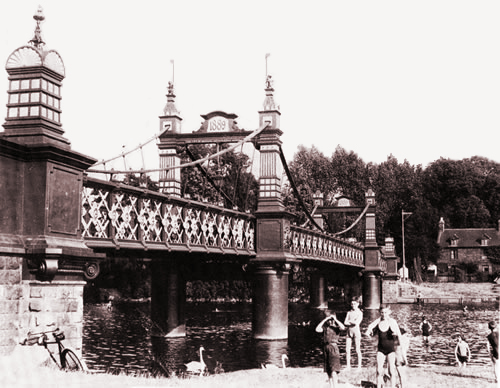
NEW FERRY BRIDGE
After purchase of the rights, there was further delay due to the fact that Sir Michael Bass wished for the bridge to be free of toll. A compromise was eventually reached and it was agreed to charge a toll of one half-penny per person until the Corporation had recovered the money for the purchase of the ferry rights. The Town Council decided to spend £50 on the erection of two turnstiles on the Stapenhill side of the bridge in order to enable them to accomplish this aim.
A Mr and Mrs Whitney were appointed by the Town Corporation as toll-keepers and notice boards were erected providing the opening and closing times of the bridge and the toll fees for using it. Although there was no cause for the Ferry to still operate, the new bridge still had a toll to recover the cost of construction. The Ferry House was therefore occupied by Ferry Bridge Toll Collectors who were now employed by the Town Corporation though the much lighter job probably didn’t warrant having a house supplied with it!
However, Thomas Whitney and his wife Anne moved in as Toll-Keepers and they were, not altogether surprisingly, still occupants of the Ferry house ten years later, in 1901. By now, Thomas Whitney’s occupation was recorded as ‘Corporation Labourer’ since the Ferry Bridge was freed of toll three years earlier in 1898.
At the banquet at St Paul’s Institute following the official opening, Sir Bass had announced that he was to erect a raised causeway across the meadows join the Ferry Bridge to Burton. A few days after the ceremony, the Town Council received a letter from Sir Michael dated 9th April 1889, confirming his proposal. The erection of an iron viaduct was begun and this was presented to the town in 1890. This elevated the total cost of the bridge from around £7,000 to £10,000.
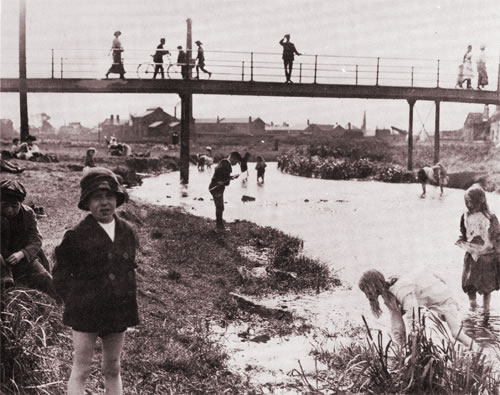
At the time the causeway was built, it had to cross another branch of the river which was a common play area in the summer. The slightly raised section can still be seen but the river has long gone.
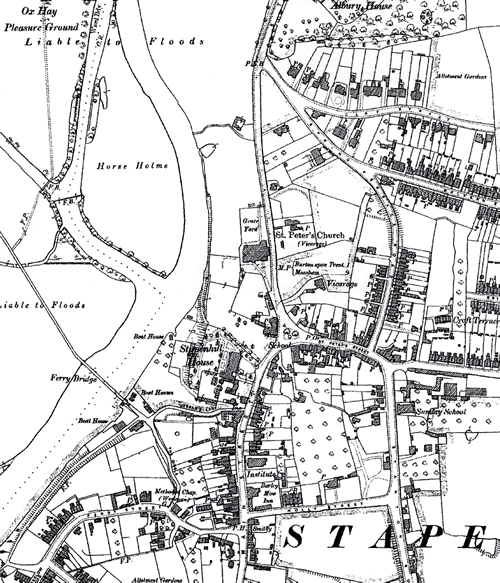
A new Ordanance Survey map was prepared in 1900 which showed the Ferry Bridge and Causeway officially ‘on the map’!
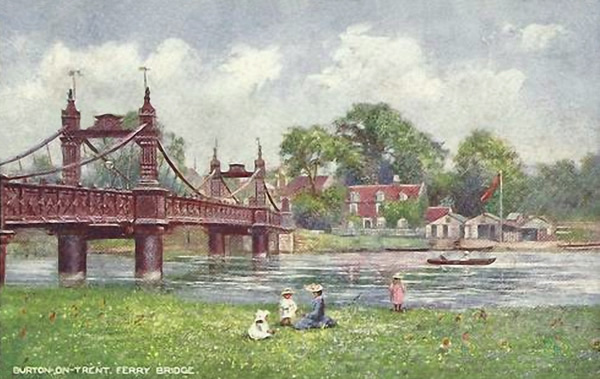
The bridge soon became the subject of a number of Burton postcards.
TOLL FREE
On April 21st 1898, the ‘Burton Chronicle’ reported:
“Lord Burton’s latest donation to the town is a cheque for £230 to clear the Ferry Bridge of its debts. Ever since the structure was built, he has received a yearly statement of accounts, showing the progress of the tolls which it was necessary to create to pay off the loan of nearly £13,000, the price paid to the Marquis of Anglesey for his ferry rights. On the receipt a short time ago of the last balance sheet, he decided to wipe off the incubus, so the people have witnessed the freeing of the bridge two months earlier than anticipated”.
The early freeing of the toll on April 13th 1898 came as a complete surprise. A Stapenhill resident at the time, Mr Harold Lewis, who used the Ferry Bridge on a regular basis recalled walking across on his journey to work in Burton, where he was employed by Messrs. Worthington’s in their brewery offices. He and other travellers, not to mention the Town Council, all expected the enforcement of the toll to continue for several more months.
The Council had no opportunity to give notice of Lord Burton’s generous offer to wipe out the remaining debts on the ferry rights so on the way home from his work at the brewery, Mr Lewis stopped as usual, to purchase a weekly ticket from the toll collectors, Mr and Mrs Whitney, at a cost of 4d. The next morning, on his way to work, he went to present his ticket to a non-existent collector, for unknown to Mr Lewis, the bridge had been declared free of toll the previous night.
Many users of the Ferry Bridge retained their toll tickets dated April 13th 1898, as a souvenir as a momento of the last day of a toll being charged.
On the shelter positioned on the causeway, it is still possible to read the declaration:
THIS BRIDGE AND VIADUCT
WERE PRESENTED TO THE BOROUGH OF BURTON UPON TRENT
BY THE RIGHT HONOURABLE MICHAEL ARTHUR BARON BURTON
AND THE BRIDGE WAS DECLARED FREE OF TOLL BY THE CORPORATION
ON THE THIRTEENTH DAY OF APRIL 1898
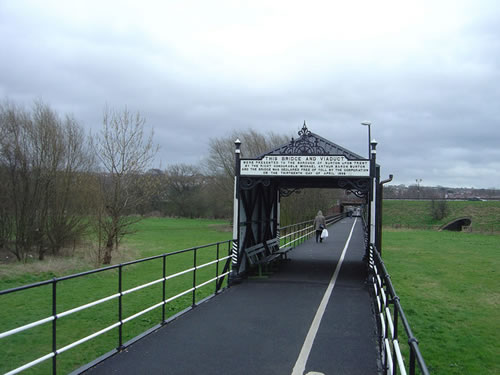
The following Sunday, April 24th 1898, was the first free Sunday on the bridge. A kind of ‘Children’s Carnival’ took place on that warm Spring day, when lots of children attended the bridge to celebrate the freeing of the toll. The only person who failed to appreciate the occasion, apparently, was an old blind beggar who regularly stood at the Stapenhill end of the bridge, hoping to receive a few coppers from the public using the crossing. The youngsters had great fun, tormenting the poor chap mercilessly, whilst being watchful of his stout cudgel which kept them at bay. Happily, no one came to any harm on this day of light-hearted fun and celebration, when people could look forward to taking the walk to town free and forever more.
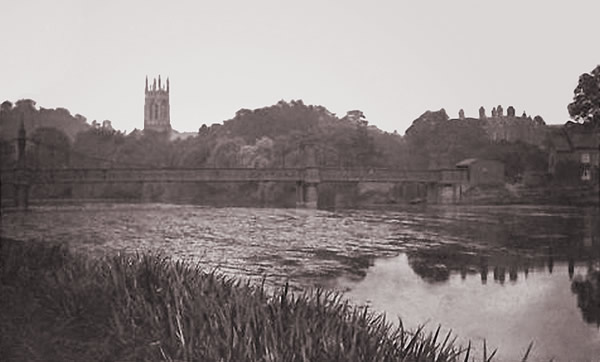
Taken in 1915 from across the river, the above photo gives a marvellous view of Stapenhill House, whose grounds eventually became Stapenhill Gardens, with the Ferry Bridge in the foreground providing a very good feel of how imposing the house would have been to people walking across the bridge.
As cycling gained ever increasing popularity with the public, both for pleasure and as an easy and convenient way of getting to work, people were tempted into cycling across the bridge and viaduct This was strictly prohibited and notices made of cast-iron were erected at both the Stapenhill and Burton approaches to the crossing, warning the public that they risked a fine of forty shillings (£2.00) if they were caught breaking the law in this regard.
Despite this, a great number of the public chose to ignore these warnings and over the long period that these restrictions remained in force, many of them found themselves in court after being confronted by a waiting member of the police force, who were occasionally instructed to stand at one end or other of the bridge to catch perpatrators. They would also quite often have to suffer the indignity of reading their name in the Burton Mail in the list of court cases
As time went by, the fine for cycling across the bridge rose considerably, eventually rising to as much as £10.00. It became common practice to traverse the bridge by standing on a pedal with one foot and scooting along with the other and quickly stepping off to resume walking at the first sight of a police uniform.
In recent years, restrictions on cycling were finally lifted and a special, narrow cycling lane was marked out across the whole length of the bridge and viaduct. The bridge and viaduct remain in good use and a new tunnel was added when the new Saint Peters Bridge was built so that the causeway could be retained.
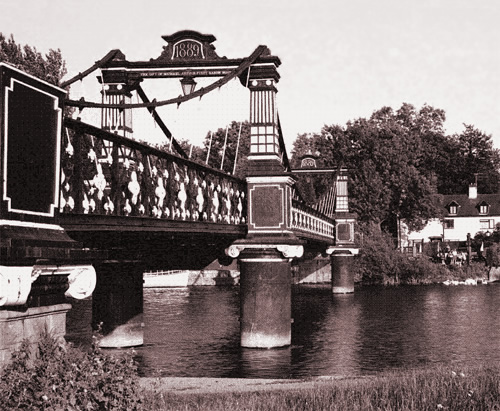
For a brief period, there was another ‘ferry’, The ‘Dingle Belle’, this time for pleasure and operating from the Stapenhill Gardens side of the Ferry Bridge. This was a private enterprise intended to commemorate the days of the ferry with pleasure trips up and down the river, beginning and ending at the Ferry Bridge. It can be seen in the above picture, fittingly taken through the Ferry Bridge, at its small loading jetty.
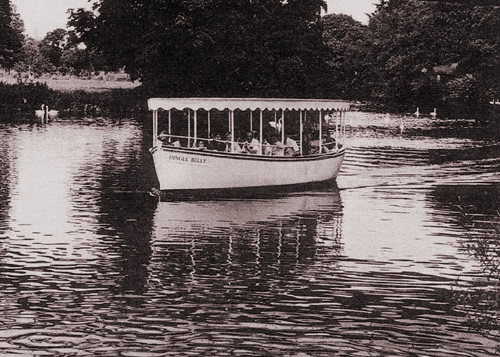
Unfortunately, after the initial novelty, it failed to attract enough ongoing business to make it viable.
COUNCILLOR C.H.DOBSON
After James Dalton, the person probably most associated with the Stapenhill Ferry House is Councillor C.H.Dobson.
Mr Dobson brought the Ferry House in 1911 for him to set up a business on the ferry site as a Boat Builder, where he later became a well-known and respected figure in the community. The business thrived and during the summer months, the hiring of boats at the ferry in order to take a pleasant trip up or down the river, proved to be very popular with people.
The river, however was not without its dangers, and Mr Dobson, who had served throughout the 1914-18 War, was called upon at least three times during his time at the ferry, to launch himself into the river to save someone from drowning. In 1943, he was honoured with the Parchment of the Royal Humane Society for Gallantry for saving a woman from drowning in the River Trent. Mr Dobson was also a member of Burton Town Council, to which he was first elected in 1937, as a representative of the Uxbridge Ward.
The Burton Observer reported on 22nd July 1943:
BURTON COUNCILLOR’S RIVER RESCUE
Mr C.H. Dobson Receives Parchment from Mayor.
Before the start of the ordinary business of the monthly
meeting of Burton Town Council last week, the Mayor,
Councillor F.G.Thompson, presented to Councillor C.H.Dobson
the parchment of the Royal Humane Society, for gallantry in
saving a woman from drowning in the river Trent last
February.
The Mayor read a letter from a witness of the “timely and
plucky rescue” by Councillor Dobson who jumped fully clothed
into about six feet ot flowing water.
The Mayor said that he believed this was the third occasion
on which Councillor Dobson had saved people from drowning in
the river Trent but as he was a very modest man, no formal
recognition had hitherto been shown towards him.
Making the presentation of the parchment to Councillor
Dobson, the Mayor said: “We know full well that Councillors
are brave men; they have to be to stand up and air their
convictions, but Councillor Dobson has gone a little bit
further by showing that apart from being a man of words, he
is also a man of deeds”.
“You have done great credit to us as a body and we are
grateful to you for your example”, the Mayor told Councillor
Dobson.
The Council endorsed these remarks by acclamation.
Mr Dobson continued to run his business at the ferry site successfully for many years although, on occasions, he was presented with a few headaches when the Trent was in flood. On November 27th 1954, the water rose dramatically, flooding his main workshop to a depth of several feet. The flood water receded later the following week, when Mr Dobson was photographed by a cameraman from the Burton Observer, busy at work in his flooded boathouse wearing Wellington’s, the water still a few inches deep, lapping around his ankles.
In or around 1959, he and his son, John, moved to Shardlow where they carried on the business of Boat Building, after selling the premises at Stapenhill. In January 1969, Mr Dobson died at the age of 78 years, at his home at Shardlow.
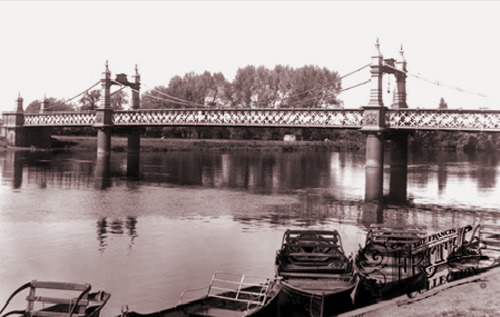
The ferry site business was purchased from Mr Dobson by two brothers, Ronald and John Sheffield, whose intentions were to continue the business of hiring boats out to the public and run the enterprise much the same as their predecessors. Sadly, this was not to be, for after only three years or so they were forced to give up the business because of continued acts of vandalism by selfish, mindless individuals, who were responsible for damaging the boats, throwing oars into the river and causing many other problems for the owners. The business was sold and the brothers moved to premises in Burton-on-Trent, where they began another enterprise which they ran successfully and trouble free, under the name of ‘Ideal Insulations’.
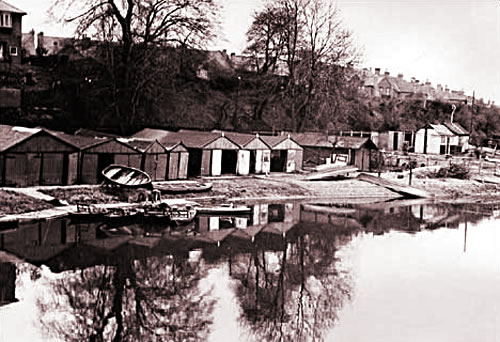
The Ferry House and boat-yard changed hands perhaps two or three times following the departure of the Sheffields’ but boats continued being available for hire at the ferry site, but a few were sold off, some of which were in use some years later on the boating lake at Drayton Manor Theme Park, still clearly displaying in white lettering, ‘Stapenhill Ferry’.
Around 1974 the premises were acquired by Mr and Mrs R. Collins, who bought the site and replaced old and rotting boats with new ones. They then had a mobile home moved on to the site where they started the planning and building of a riverside restaurant, after tearing down the old and dilapidated boathouses. The new restaurant, which took a year to build, was called, ‘The Boathouse Restaurant’, and was officially opened on Saturday, 26th. April 1975, by actor Stephen Hancock, otherwise known as ‘Ernie Bishop’, a star in the television soap, ‘Coronation Street’.
1969 ‘RESTORATION’ (Rape)
In 1969, some eighty years after the bridge had been erected the elements had taken their toll on the structure. The outer metal casing on the huge piers that supported the bridge had started to rust and, in places, had cracked, allowing water to seep inside the casing. Specialists were called in to examine the whole structure.
BEFORE

After close and careful examination, they came to the conclusion that the heavy, ornamental cladding had put too much weight on the structure and should be immediately removed, along with much of the decorative ironwork, including the four very attractive Victorian gas lamps, which had been mounted high on the structure at each end of the approaches to the bridge.
AFTER
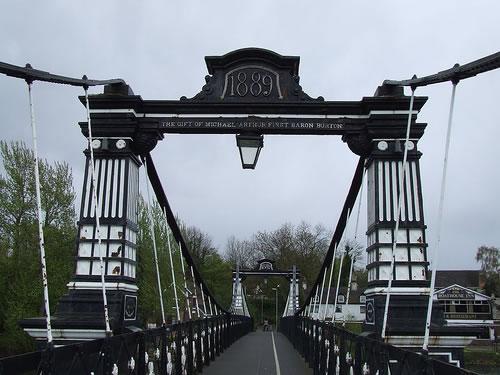
Rust had eaten into the metal work which supported the lamps and they were in danger of collapsing, as were other decorative embellishments which had adorned the bridge. The Burton Borough Engineer and Surveyor, Mr J.P. Wain, in his report to the Burton Town Council, advised the sealing of the cracks in the piers with concrete in order to prevent the same thing happening again and he recommended the stripping off altogether of the ornamental ironwork, which was in urgent need of attention. Mr Wain suggested that the iron-work should be treated with metal preserver, re-painted and then restored to their original fixtures on the bridge.
Early in February 1969, the headlines in an edition of the Burton Mail reported the serious condition of the bridge to its readers, who were deeply concerned to learn that the Ferry Bridge was actually in danger of being demolished. This concern was also voiced in a national daily newspaper which stated in its report that ‘Burton was in danger of losing its famous Ferry Bridge’. A suggestion had been put forward that the bridge should be dismantled altogether, and a new one built. It was estimated that a new bridge would cost the ratepayers in the region of £60,000. To everyone’s relief, the recommendations of the borough surveyor were accepted and the job of renovating the bridge began.
The bridge was first enveloped by a network of metal scaffolding to enable workmen to carry out the necessary renovations and the long and arduous task at last got underway, a task which carried on throughout most of the year. Eventually, with the all the necessary work completed and the scaffolding finally removed and taken away, it was found that the bridge had taken on a rather different appearance. Stripped of much of its decorative iron-work, the bridge appeared almost naked, and a stark contrast from its original state, much to the dismay and disappointment of many local people who had speculated that the bridge was to be restored to its former glory.
To add to the disappointment, the attractive burgundy and cream coat of the original had been replaced with a stark black and white which contributed to its much worse appearance.
THE FUTURE
The bridge continues to decay with no since attempts by anyone to have the bridge restored. The original lanterns and much of the ornamental iron-work and cladding remained locked away in storage. The skill and meticulous care and attention to detail that the Victorian craftsmen had taken in order to create such an impressive structure for the use and enjoyment of future generations would turn in their graves.

The causeway has also proved to be every bit as good an investment in the town as the Ferry Bridge itself. The washlands are prone to being extremely water-logged when the river is high and a simple footpath across the meadows would on many occasions have made the walk between Stapenhill and Burton impassable. The above picture shows the viaduct saving the day in 1910.

Even in modern times, the river has swelled to within a few inches of the raised walkway. The above picture was taken in 2007. A few years earlier, the lowest section had a small section with water lapping over the edge demonstrating that the necessary height was judged to perfection. At no point in well over a hundred years has the route been unavailable to the many walkers that have come to rely on it.
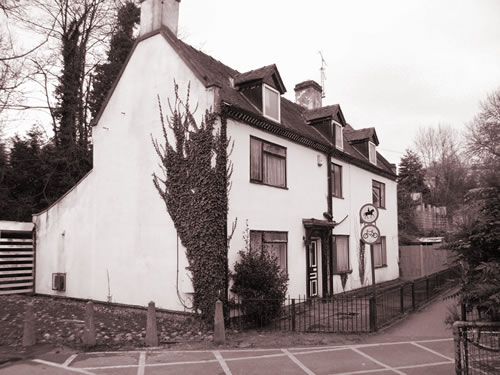
The Burton Civic Society, presented a Design Award for the renovation of the Ferry House and a commemorative plaque dated 1978 can be seen on the front of the building. Some initial work has been done in making a case for the restoration of the Ferry Bridge and, for the sake of Burton’s heritage, it is hoped that this if effective before it has to be demolished and replaced by a featureless concrete section.
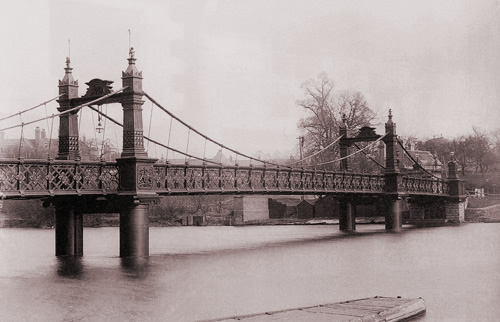
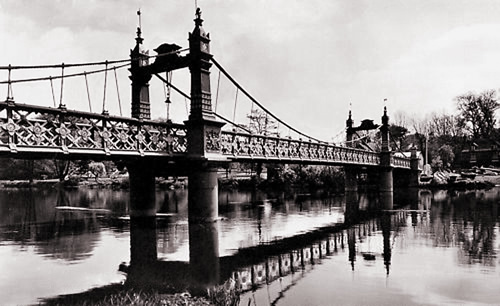
One thing is unfortunately for sure; it will never again see its original splendour.

